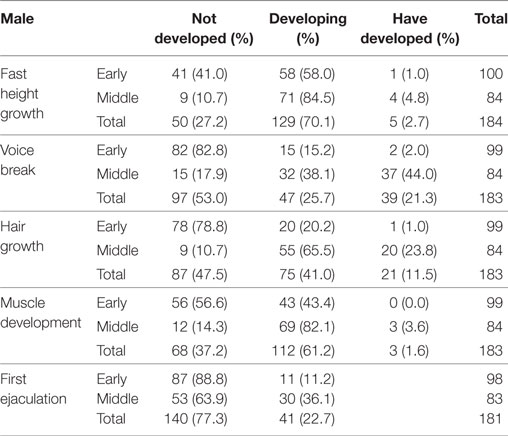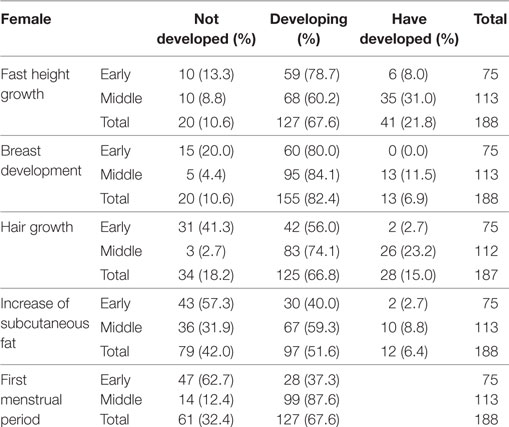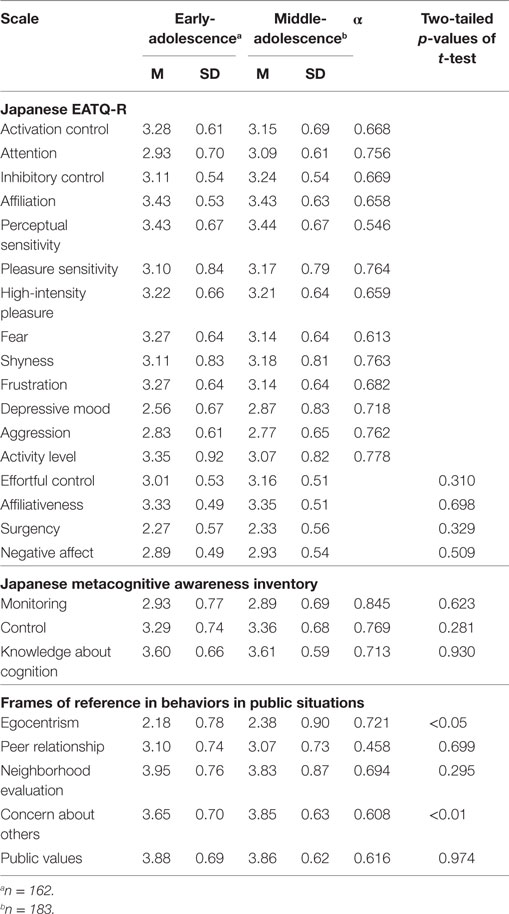- 1Department of Early Childhood Education, College of Nagoya Women’s University, Nagoya, Japan
- 2School of Humanities and Social Sciences, Nagoya City University, Nagoya, Japan
We conducted a questionnaire survey using a cross-sectional sample of early and middle adolescents aged 10–15 (n = 351) in order to investigate relationships between temperament, metacognition, and frames of reference in behaviors in public situations. The sample was divided into two groups by age (ear group: 10–12; middle-adolescence group: 13–15) and were analyzed by Multiple Group Structural Equation Modeling. Explanatory variables were four components of temperament [effortful control (EfC), affiliativeness (Afil), surgency (Sur), and negative affect (NgA)] and metacognition. Objective variables were three components of frames of reference in behaviors in public situations [egocentrism (Ego), neighborhood evaluation (Nei), and public values (Pub)]. In both age groups, EfC had a negative effect on Ego, and Sur had a negative effect on Nei. However, only in the middle-adolescence group did Afil and NgA have significant effects on Pub. Meanwhile, metacognition in the ear group had a positive effect on Ego and Nei, but these relations disappeared in the middle-adolescence group, and only in the middle-adolescence group did metacognition have a positive effect on Pub. We discuss frames of reference in behaviors in public situations from the viewpoint of the development of social cognition in early and middle adolescence in relation to temperament and metacognition.
Introduction
Our development as social beings begin within the family when we are infants and then continues in ever-widening arenas as we move through childhood and adolescence into adulthood (Selman, 2003). Recently, the number of neurobiological studies of behavioral changes occurring in adolescence has sharply increased. These findings are used to imply that adolescents have poor self-control (that is, they lack the ability to keep inappropriate emotions, desires, and behaviors in check). However, in neutral settings, adolescents show good self-control, equaling or even exceeding that shown by some adults, whereas in emotional situations, their ability to keep impulses under control is heavily overloaded compared with that of adults and children (Casey and Caudle, 2013).
Casey (2015) argues that research findings about changes specific to adolescents in terms of self-control and underlying brain organization further our understanding of the motivations behind adolescents occasionally displaying criminal behaviors. When under emotional pressure or facing potential threats or challenges from peers, emotional centers in the adolescent brain may take control of more immature prefrontal circuits, which may lead to rash behaviors. Concerning delinquent behaviors, Nagafusa et al. (2012) investigated the association between the range of groups or persons whom an adolescent cares about when acting in public situations and juvenile delinquency in children in reformatory institutions. A total of 1,248 children (aged 12–19) in reformatory institutions completed the scale for the frame of reference in behaviors in public situations (Sugawara et al., 2006). This scale has five factors: egocentrism (Ego), peer evaluation, neighborhood evaluation (Nei), concern about others (Oth), and public values (Pub). These factors reflect that the range of groups or persons whom an individual cares about when acting in public situations is gradually widening. Nagafusa et al. (2012) suggest that juvenile delinquents in reformatory institutions show a narrow range of referent frames in behaviors in public situations. That study also indicated that older juvenile delinquents showed a wider range of groups or persons whom they care about when acting in public situations compared with younger juvenile delinquents.
Given the developmental change in width in the frame of reference in behaviors shown by Nagafusa et al. (2012), this could assist self-control in adolescence. However, there have been no studies on how this expansion occurs in adolescence or how other adolescent mental functions are related to this phenomenon.
Temperament has been defined as a constitutionally based set of individual differences in reactivity and self-regulation in the domains of emotions, activity, and attention (Rothbart and Bates, 2006). An increasing number of studies of neural systems show that individual differences in temperament provide the foundation for the drive to learn, competence, and expertise (Posner and Rothbart, 2007). Factor-analytic work using parent- or self-reported behavioral questionnaires yielded broad factors of temperament, with surgency (Sur)–extraversion being positively related to mastery motivation. Affiliativeness (Afil), which is related to behaviors involving a desire for closeness with others, is assumed to be independent of measures of shyness and extraversion (Putnam et al., 2001). This is based on the biology of behaviors that could support social motivation. Another factor, called effortful control (EfC), is linked to individual differences in self-regulation and reactivity control. EfC consists of the capacity to suppress dominant reactions in preference for performing subdominant reactions, spot errors, or taking part in planning. It can be also seen as the capacity for keeping one’s behaviors, emotions, and attention under control (Rothbart, 2011). EfC is associated with the development of the prefrontal cortex (e.g., Gulley et al., 2016). It is reported that EfC—being able to regulate one’s own emotions and behaviors—in early adolescence may positively influence one’s prosocial behavior and negatively affect the self-centered tendencies observed in adolescence (Luengo Kanacri et al., 2013).
In addition to temperament, we measure metacognitive ability, which increases with age during adolescence (Weil et al., 2013). Metacognition comprises the processes through which individuals monitor and control their cognitive processes. However, it can also apply to others, a process known as “mentalizing” (Frith, 2012). When acting in a public situation, metacognitive ability is necessary to care about one’s own mind (egocentricism) and other people. Following Duckworth et al. (2014), we define metacognition as the ability to deploy a range of self-control strategies. In other words, metacognition consists of knowing what facilitates self-control instead of making it more difficult. This can be acquired directly, modeled for observation, and even practiced by schoolchildren. Duckworth et al. thus suggest that children be taught that self-control emerges most effectively through selectively avoiding—as opposed to directly controlling—inappropriate impulses, even if age-related increases in the ability to engage in metacognition play a part in the age-related maturing of self-control.
Therefore, we investigate the relations between temperament, metacognition, and frames of reference in behaviors in public situations from a developmental perspective. The aim of this study is to explore how temperaments and metacognition relate to frames of reference in behaviors in public situations in early and middle adolescence.
Materials and Methods
Participants
This survey was conducted in five elementary and three junior high schools in the Tokai region of Japan, located in the center of the country on the Pacific side and one of the most industrialized regions of the country. The questionnaires were distributed to 1,923 students and their parents. The adolescents ranged from the fifth grade of elementary school (10–11 years old) to the third grade of junior high school (14–15 years old). The collection rate was 22.7%, 80.3% of which were available data because there were no missing values in questionnaire responses from participants or their parents. Thus, in this study, only children’s self-reported answers were analyzed. Thus, data from 351 adolescents (179 females and 172 males) were analyzed.
Measures
Frames of Reference in Behaviors in Public Situations
Five ranges of groups or persons whom an individual cares about when acting [Ego, peer relationships (Peer), Nei, Oth, Pub] were measured using the scale of frames of reference in behaviors in public situations (Sugawara et al., 2006). Table 1 presents definitions and sample items for each subscale. This scale has 20 items, which were rated by the participants on a five-point scale from “never” to “almost always.” Subscale scores were calculated by averaging the scores of applicable scale items.
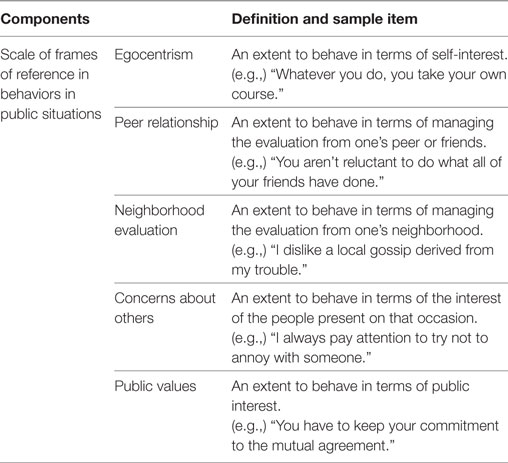
Table 1. Subscale definitions and sample items for frames of reference in behaviors in public situations (Sugawara et al., 2006).
Japanese Version of the Revised Early-Adolescence Temperament Questionnaire (Japanese EATQ-R)
Four components of temperament [EfC, Afil, Sur, and negative affect (NgA)] were measured using the Japanese version of EATQ-R, which was developed by Sukigara et al. (2013) based on the original EATQ-R (Ellis and Rothbart, 2001). This questionnaire has 103 items classified into 13 subscales: activation control (AC), activity level, affiliation (Af), attention (At), fear (Fe), frustration (Fr), high-intensity pleasure (HIP), inhibitory control (IC), perceptual sensitivity (PS), pleasure sensitivity (PlS), shyness (Sh), depressive mood (DM), and aggression (Ag).
The self-report form asks adolescents to circle the answer that best describes how true each statement is for them. Response options use a five-point Likert-type scale: 1 = almost always untrue; 2 = usually untrue; 3 = sometimes true, sometimes untrue; 4 = usually true; and 5 = almost always true. Appropriate items were reverse scored, and subscale scores are computed as an average score of applicable scale items.
We calculated four dimension score, as follows:
i. EfC: average of scale scores for: AC, At, and IC.
ii. Afil: average of scale scores for: Af, PS, and PlS.
iii. Sur: average of scale scores for: HIP, Fe, and Sh. However, Fe and Sh were inverted and summed.
iv. NgA: average of scale scores for: Fr, DM, and Ag.
Japanese Metacognitive Awareness (MC) Inventory
To measure the participant’s MC, we used the adults’ metacognition scale, which was constructed using items from the MC inventory (Schraw and Dennison, 1994) adapted for Japanese by Abe and Ida (2010). The wordings of the inventory items were adjusted so that adolescents could understand it. This scale has 28 items classified into three factors: monitoring (Mon), control (Ctl), and metacognitive knowledge (Knw). Table 2 presents definitions and sample items for each subscale. These items were rated by the participants on a five-point scale from “never” to “almost always.” Each subscale score was the arithmetic mean of applicable scale items.
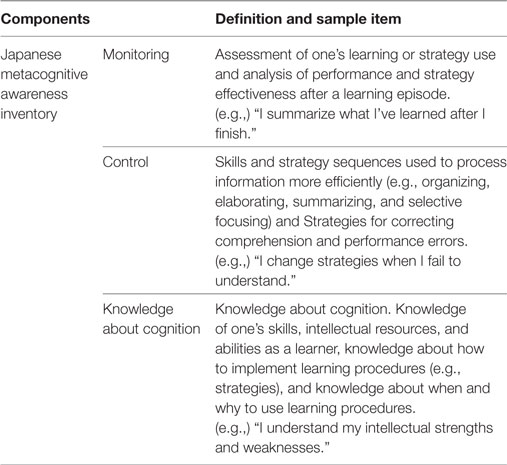
Table 2. Subscale definitions and sample items for Japanese metacognitive awareness inventory (Schraw and Dennison, 1994; Abe and Ida, 2010).
Pubertal Status
Pubertal status was assessed via self-report using the body changes questionnaire, a scale adapted from Kaminaga (2007). Both male and female adolescents were asked to report on the pubertal development of body hair growth and growth spurts in height: males were also asked about voice changes, muscular body, and first ejaculation; females were asked about breast growth, subcutaneous fat, and menstruation. Four questions had the following options: “not yet,” “in progress,” and “have completed.” First ejaculation or menstruation was assessed via “No” or “Yes.”
Four questions for males and females were scored as follows: “not yet” = 1, “in progress” = 2, and “have completed” = 3. The last item was scored as follows: “No” = 1, “Yes” = 2. Overall scores were calculated by summing all items for which a score was given, and the sum of the scores was divided by five.
Validity of Scales
For frames of reference in behaviors in public situations, in our models shown below, covariate coefficients between Ego and Pub scores, Nei and Pub scores were negative, and one between Ego and Nei score was positive. These were consistent with the results of the interfactorial correlation of the scale of frames of reference in behaviors in public situations in Nagafusa et al. (2012). Therefore, it is suggested that a factorial validity of used scales was confirmed.
According to Muris and Meesters (2009), the reliability and validity of the self-report version of the EATQ-R in early adolescents (n = 1,055) are acceptable. For Japanese EATQ-R, the same structure as Muris and Meesters (2009) was confirmed in the models shown below; this suggested that the factorial validity was confirmed.
For Japanese MC inventory, a confirmatory factor analysis was carried out and a factor structure similar to that of Abe and Ida (2010) was confirmed. This suggests that factorial validity has been confirmed.
Procedure
The questionnaires were distributed to students and their parents by each classroom teacher, and the participants were asked to drop the questionnaire into a post box after filling in answers. The cover page of the questionnaire mentioned that “Answering the questionnaire is not an obligation. Please only answer if both the parents and the children are willing to answer the questionnaire.” Therefore, all the parents provided written informed consent concerning their and their children’s participation. If the questionnaire came back with responses, the adolescent participants received a gift certificate worth ¥ 500 ($4.50) as a token of our appreciation.
This research project was approved by the Ethical Committee of Nagoya City University (No. 12002). This questionnaire was anonymously completed by the participants.
Data Analysis
The responses of participants were analyzed with multiple group structural equation modeling, using R (R Core Team, 2017) and lavaan (Rosseel, 2012) software packages. In this analysis, the covariances of the latent variables that showed low interfactorial correlation, and non-significant paths in both groups were eliminated. The model was assessed for goodness-of-fit using the comparative fit index (CFI), Tucker–Lewis index (TLI), the rootmean square error of approximation (RMSEA), and the standardized root mean square residual (SRMR).
Results
Descriptive Statistics
The states of development of adolescent physical development in males/females for each group were shown in Tables 3 and 4. To allow a cross-sectional analysis, the adolescents were divided into two groups by age. Figure 1 shows the mean pubertal development scores for female and male as a function of age. Changes in adolescent hormones are related to temperament and adolescent risk orientation; so we grouped the participants based on their sexual maturity. Since sexual maturity greatly differs between the ages of 12 and 13, they were divided into two groups of 10–12-year-old and 13–15-year-old [early adolescence (E): 10–12 years old (n = 165; 73 females, 92 males), and middle adolescence (M): 13–15 years old (n = 186; 106 females, 80 males)]. Average scores and SD for each component for each group are summarized in Table 5. Following a t-test, a significant difference (p < 0.05) was found in the average score only for two components (shown in Table 5). However, no clear trend was found for age.
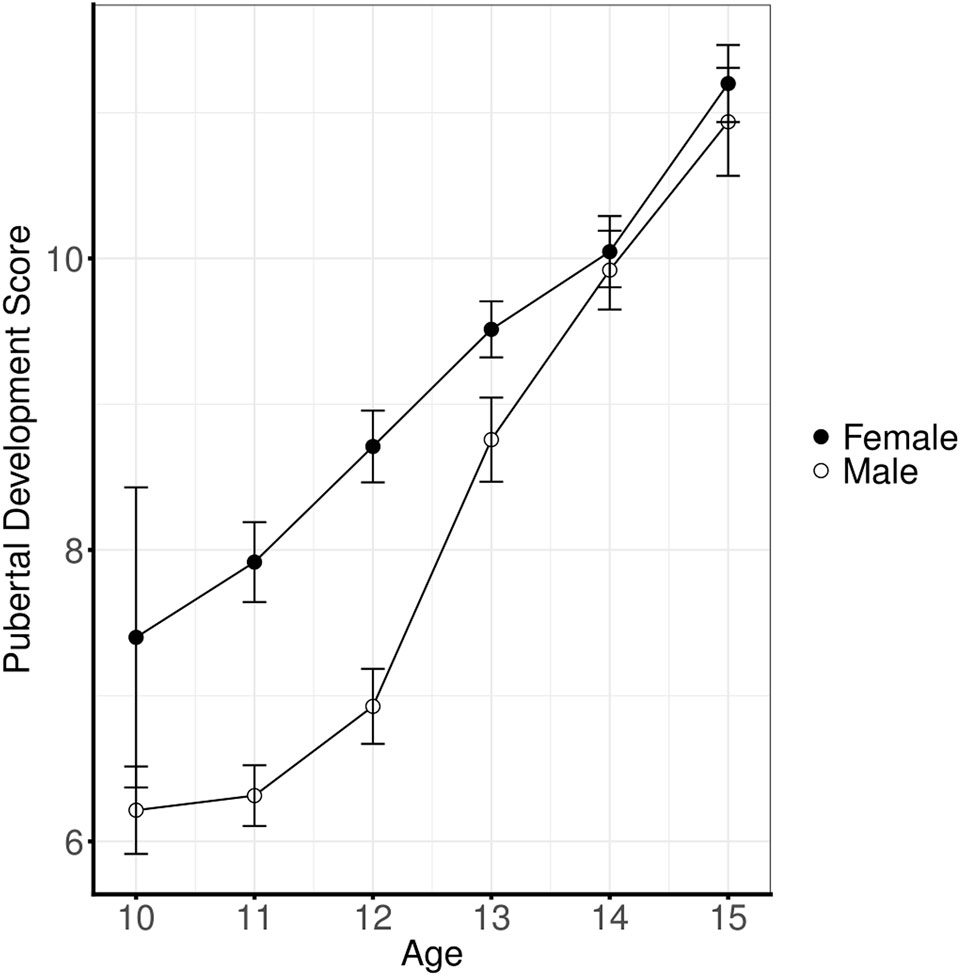
Figure 1. Mean pubertal development scores for female and male as a function of age. Vertical bars indicate the standard errors.
Analysis by Multiple Group Structural Equation Modeling
Multiple group structural equation modeling was used to examine the relations between temperament and MC as well as the frames of reference in behaviors in public situations due to age differences. We calculated metacognition score (MC) as the average of three subscales (Mon, Ctl, and Knw) scores, since the correlations between the three subscales were high, respectively. Regarding frames of reference in behaviors in public situations, the correlations between Peer and Nei [r(364) = 0.400, p < 0.000], Oth and Pub [r(364) = 0.463, p < 0.000] were both high. From the viewpoint of simplifying the model by reducing latent variables and observed variables, Peer and Oth are omitted from the model. Thus, only Ego, Nei, and Pub were included into the model. Inoue (1977) has divided the Japanese social space into three categories, i.e., “Miuchi, Seken, and Tanin,” which correspond to the remaining variables Ego, Nei, and Pub, respectively. Explanatory variables were the components of temperament and MC, and objective variables were the components of the frames of reference in behaviors in public situations. The path diagrams are shown in Figure 2 for the early-adolescence group and Figure 3 for the middle-adolescence group (CFI = 0.768; TLI = 0.730; RMSEA = 0.080; SRMR = 0.091). As can be seen, in both groups, EfC was negatively related to Ego, and Sur had a positive effect on Nei. However, in these models, as the coefficient of Sur is inverted between positive and negative, this indicates that the higher the characteristics of Sur, the lower the tendency to care about Nei.
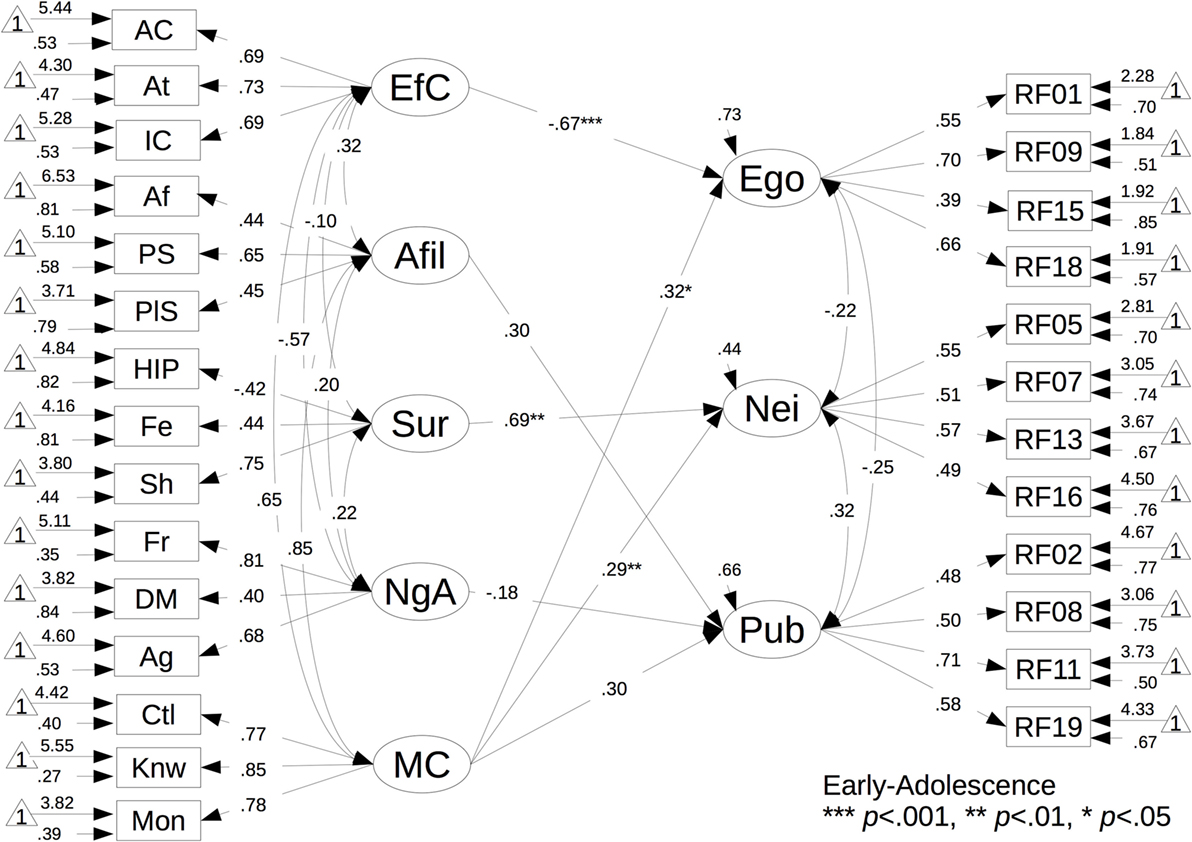
Figure 2. Path diagrams for early-adolescence group for temperament, metacognition, and frames of reference in behaviors in public situations by multiple group structural equation modeling. EfC, effortful control; Afil, affiliativeness; Sur, surgency; NgA, negative affect; AC, activation control; At, attention; IC, inhibitory control; Af, affiliation; PS, perceptual sensitivity; PlS, pleasure sensitivity; HIP, high-intensity pleasure; Fe, fear; Sh, shyness; Fr, frustration; DM, depressive mood; Ag, aggression; MC, metacognitive awareness; Mon, monitoring; Ctl, control; Knw, metacognitive knowledge; Ego, egocentrism; Nei, neighborhood evaluation; Pub, public values. *p < 0.05, **p < 0.01, ***p < 0.001.
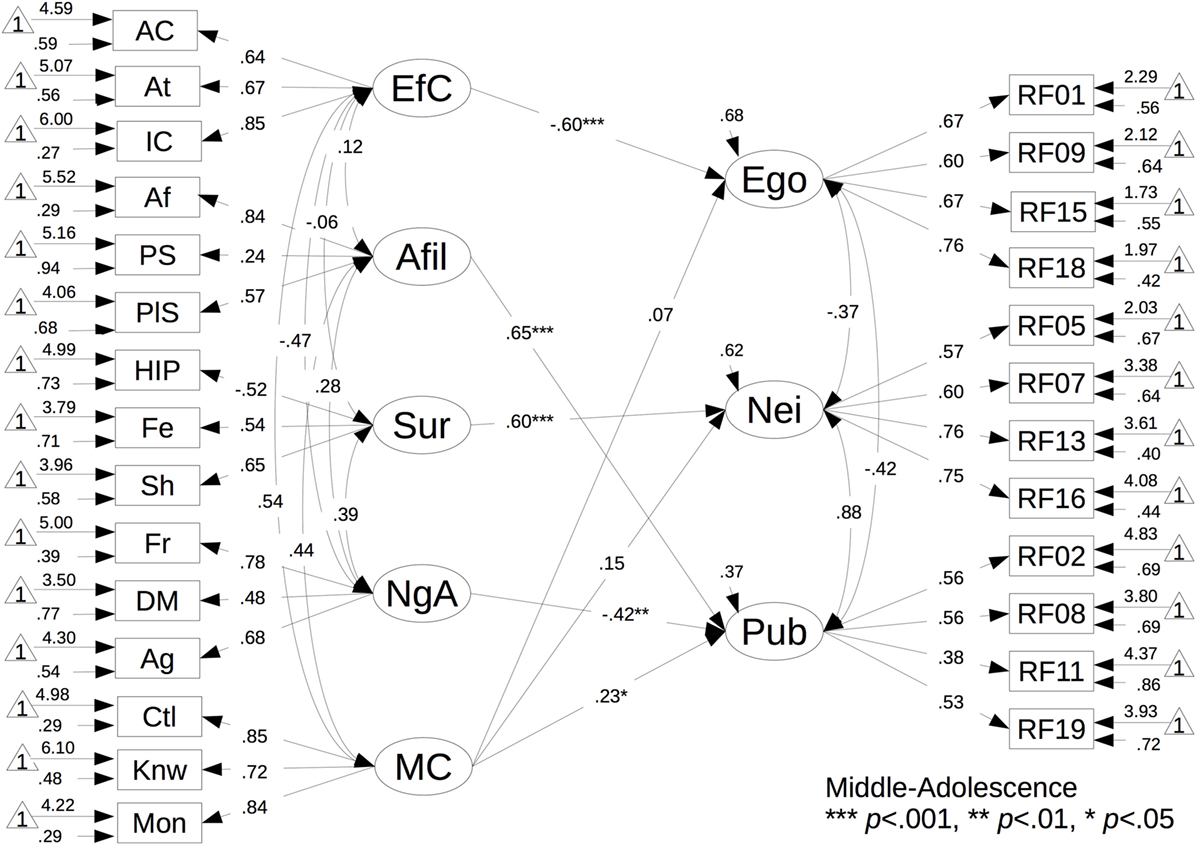
Figure 3. Path diagrams for middle-adolescence group for temperament, metacognition, and frames of reference in behaviors in public situations by multiple group structural equation modeling. EfC, effortful control; Afil, affiliativeness; Sur, surgency; NgA, negative affect; AC, activation control; At, attention; IC, inhibitory control; Af, affiliation; PS, perceptual sensitivity; PlS, pleasure sensitivity; HIP, high-intensity pleasure; Fe, fear; Sh, shyness; Fr, frustration; DM, depressive mood; Ag, aggression; MC, metacognitive awareness; Mon, monitoring; Ctl, control; Knw, metacognitive knowledge; Ego, egocentrism; Nei, neighborhood evaluation; Pub, public values. *p < 0.05, **p < 0.01, ***p < 0.001.
Metacognitive awareness in the early group had positive effects on Ego and Nei, but these relations disappeared in the middle group. On the other hand, in the middle group, Afil has a positive effect, and NgA has a negative effect on Pub. MC also has a positive effect on Pub.
Discussion
The purpose of the present study was to investigate the relations between temperament, metacognition, and frames of reference in behaviors in public situations from a developmental perspective in early and middle adolescence (aged 10–15 years old). To allow for a cross-sectional analysis, the adolescents were divided into two groups by age (early adolescence: 10–12 years old; middle adolescence: 13–15 years old). We demonstrated, in both groups, the higher the EfC, the lower the tendency to Ego, and the higher the Sur, the lower the tendency to care about Nei. On the other hand, as for differences depending on age, metacognition in the early group had positive effects on Ego and care about Nei. While in the middle group, Afil had a positive effect, and NgA had a negative effect on Pub.
Egocentrism in frames of reference in behaviors in public situations is the tendency to follow one’s own desire without respecting others. It is thought that consideration of others is based on theory of mind, that is, understanding of their own and other individuals’ mental states. EfC refers to the ability to inhibit a dominant response in order to perform a subdominant response (Rothbart, 2011). Many studies indicate that EfC (or self-regulation) was significantly related to theory of mind in toddler and preschool children (Carlson and Moses, 2001; Carlson et al., 2004; Sabbagh et al., 2006; Hughes and Ensor, 2007; Korucu et al., 2017), and middle childhood (aged 7–12 years old) (Bock et al., 2015). In this study, we confirmed a similar trend in early and middle adolescence.
Furthermore, Ego can be regarded as antisocial trend. Nagafusa et al. (2012) suggested that juvenile delinquents in reformatory institutions had higher scores of Ego, compared with juvenile non-delinquents. Kochanska et al. (1997) show strong links between IC and multiple, diverse measures of children’s conscience at early school age, including observations of moral conduct, moral cognition, and moral self in toddler and early school age. The present result that EfC seems to suppress Ego is consistent with the result of Luengo Kanacri et al. (2013).
Surgency consists of individual differences in the need to seek new sensations in early- and mid-adolescence (Capaldi and Rothbart, 1992). Sensation-seeking relates to the strength of a person’s desire for new experiences and need for sensory triggering (Arnett, 1992; Zuckerman, 1994). It is also linked with a predilection for high-risk activities, such as reckless driving, varied sexual experiences, stimulant use, low-level criminal acts (Arnett, 1992), and antisocial behavior (Mann et al., 2017). Adolescents are frequently considered more extreme in their sensation-seeking compared with children or adults, a view backed by empirical studies (Arnett, 1992). On the other hand, Nei represents an extent to behave in term of managing the evaluation from one’s neighborhood. In other words, the fact that Nei is low means that the person does not mind the evaluation from his neighborhood. In our result, higher the characteristics of Sur, lower are the Nei. In other words, when Sur is high, it means one acts against one’s neighborhood’s evaluation. As mentioned above, sensation-seeking has high relevance to antisocial behavior, so the results of this study also support it.
Metacognition in the early adolescence had positive effects on Ego and Nei. On the other hand, in middle adolescence, metacognition had a positive effect on Pub. Considering the frames of reference in behaviors in public situations from the viewpoint of development of social cognition, it can be regarded as corresponding to each stage of Selman’s social perspective taking (Selman, 2003). Based on his theory, children from 3 to 5 years old are at Level 0: to understand my own perspective [first-person (egocentric) and physicalistic level]. From 6 to 7 years old, children are at Level 1: to understand your perspective, distinct from mine (first-person and subjective level). From about 8–11 years old, children are at Level 2: to understand your view of my (subjective) perspective (second-person and reciprocal level). From about 11–14 years old, children are at Level 3: to understand her or his view of us (our perspective) (third-person and mutual level). The final stage is Level 4: to understand my own perspective in the context of multiple perspectives (third-person and generalized other level) (ages 15–18). In this stage, the adolescent now considers others’ perspectives with reference to the social environment and culture that the other person comes from, assuming that the other person will believe and act in accord with their society’s norms and values. It can be thought that Level 0 and 1 in this theory corresponds to Ego in the frames of reference in behaviors in public situations, Level 2 to Peer and Nei, Level 3 to Oth, and Level 4 corresponds to Pub.
Monitoring others’ perceptions by applying metacognition to others is called “mentalizing” (Frith, 2012). Metalizing, in other words, is taking another person’s perspective. In early adolescence, the participants were considered to be at Level 2. In this stage, since metacognition is used for perspective taking familiar others, metacognition is thought to have had a positive effect on Nei. Also, since it is also possible to re-capture one’s sense of self from the viewpoint of a third party, it is thought that the focus on myself has increased, and the effect of metacognition on Ego has also increased. In middle adolescence, the effect of metacognition on Pub was moderate. This result may mean that people with advanced metacognition can acquire a more abstract perspective of others and thereby have a public perspective.
In middle adolescence, Afil had a positive effect on Pub. Afil covers a spectrum of behaviors promoting emotional links with other humans, including emotion-based communication, closeness, and responsiveness in human interactions (Ellis, 2002). From the viewpoint of evolutionary psychology, it is thought that sociality has developed to maintain and develop the group and help individuals behave well in the group. From the viewpoint of indirect reciprocity (Nowak and Sigmund, 1998), Afil is not only cooperation with the surrounding people, but may be related to the orientation of the altruistic behavior of the entire population.
In middle adolescence, occurring neuroendocrine changes might be particularly associated with aggressive risk-taking behaviors in boys or the tendency to affiliate with deviant peers in girls (Vermeersch et al., 2008). These might reflect the present negative effects, made up of scales measuring Ag, Fr, and DM. One of the reasons for the negative relations between NgA and Pub might be the adolescence risk-taking tendency.
In contrast, in early adolescence, neither the relation between Afil and Pub nor the relation between NgA and Pub was statistically significant. As they are taught by teachers or parents to think about the Pub, the relations were not confirmed between temperament or metacognition and Pub.
Finally, we show the limitations of this research. Tasks or evaluations by familiar adults (parents or teachers) were often used to evaluate EfC or self-regulation skills. We use self-report questionnaires to assess temperament and metacognition. In particular, in order to evaluate metacognition by sense of self, it is necessary to develop meta-Mon, which is part of metacognition. Therefore, it is unclear exactly how metacognition have been evaluated in adolescence during which metacognition is developing. Moreover, the questionnaire to assess metacognition was based on the adult version. Even if we changed the expression of the questionnaire for adolescence, there is a possibility that metacognition of adolescent was not measured correctly. And we conducted a cross-sectional survey. The data were collected at one time point, so we cannot draw inferences about causality. A further longitudinal examination is required.
Ethics Statement
This research project was approved by the Ethical Committee of Nagoya City University (No. 12002). This questionnaire was completed anonymously by the participants. The cover page of the questionnaire mentioned that “Answering the questionnaire is not an obligation. Please only answer if both parents and children are willing to answer the questionnaire.” Therefore, all parents provided written informed consent concerning participation of both themselves and their children.
Author Contributions
NK drafted the manuscript and is responsible for the interpretation of data. KK is responsible for the analysis, and interpretation of data. AN is responsible for the acquisition, and interpretation of data.
Conflict of Interest Statement
The authors declare that the research was conducted in the absence of any commercial or financial relationships that could be construed as a potential conflict of interest.
Acknowledgments
We would like to thank Mika Furuta, Naoko Kaigawa, and Terumi Aoki for their cooperation. And we would like to also thank Mamiko Abe and Masanori Ida of Rissho University, who pleasantly allowed us to use the Adults’ Metacognition Scale. This research was supported by a Grant-in-Aid for Research in Nagoya City University and JSPS KAKEN Grant Number JP16H03733 for Atsuko Nakagawa.
References
Abe, M., and Ida, M. (2010). An attempt to construct the adults’ metacognition scale: based on metacognitive awareness inventory. J. Psychol. Rissho Univ. 1, 23–34. (in Japanese)
Arnett, J. J. (1992). Reckless behavior in adolescence: a developmental perspective. Dev. Rev. 12, 339–373. doi: 10.1016/0273-2297(92)90013-R
Bock, A. M., Gallaway, K. C., and Hund, A. M. (2015). Specifying Links between Executive Functioning and Theory of Mind during Middle Childhood: Cognitive Flexibility Predicts Social Understanding. United States: Faculty Publications-Psychology. ISU ReD: Research and eData.
Capaldi, D. M., and Rothbart, M. K. (1992). Development and validation of an early adolescent temperament measure. J. Early Adolesc. 12, 153–173. doi:10.1177/0272431692012002002
Carlson, S. M., Mandell, D. J., and Williams, L. (2004). Executive function and theory of mind: stability and prediction from ages 2 to 3. Dev. Psychol. 40, 1105–1122. doi:10.1037/0012-1649.40.6.1105
Carlson, S. M., and Moses, L. J. (2001). Individual differences in inhibitory control and children’s theory of mind. Child Dev. 72, 1032–1053. doi:10.1111/1467-8624.00333
Casey, B. J. (2015). Beyond simple models of self-control to circuit-based accounts of adolescent behavior. Annu. Rev. Psychol. 66, 295–319. doi:10.1146/annurev-psych-010814-015156
Casey, B. J., and Caudle, K. (2013). The teenage brain: self-control. Curr. Dir. Psychol. Sci. 22, 82–87. doi:10.1177/0963721413480170
Core Team R. (2017). R: A Language and Environment for Statistical Computing. Vienna, Austria: R Foundation for Statistical Computing. Available at: https://www.R-project.org/
Duckworth, A. L., Gendler, T. S., and Gross, J. J. (2014). Self-control in school-age children. Educ. Psychol. 49, 199–217. doi:10.1080/00461520.2014.926225
Ellis, L. K. (2002). Individual Difference and Adolescent Psychosocial Development [Dissertation]. Eugene: University of Oregon.
Ellis, L. K., and Rothbart, M. K. (2001). “Revision of the early adolescent temperament questionnaire,” in Poster Session Presented at the 2001 Biennial Meeting of the Society for Research in Child Development (Minneapolis, MN).
Frith, C. D. (2012). The role of metacognition in human social interactions. Philos. Trans. R. Soc. B Biol. Sci. 367, 2213–2223. doi:10.1098/rstb.2012.0123
Gulley, L. D., Hankin, B. L., and Young, J. F. (2016). Risk for depression and anxiety in youth: the interaction between negative affectivity, effortful control, and stressors. J. Abnorm. Child Psychol. 44, 207–218. doi:10.1007/s10802-015-9997-7
Hughes, C., and Ensor, R. (2007). Executive function and theory of mind: predictive relations from ages 2 to 4. Dev. Psychol. 43, 1447–1459. doi:10.1037/0012-1649.43.6.1447
Inoue, T. (1977). The Structure of "Sekentei"—An Essay of Japanese Socio-Psychological History. Tokyo: Nippon Housou Kyoukai Publishing. (in Japanese).
Kaminaga, M. (2007). Pubertal development and depression in adolescent boys and girls. Jpn. J. Educ. Psychol. 55, 21–31. (in Japanese) doi:10.5926/jjep1953.55.3_370
Kochanska, G., Murray, K., and Coy, K. C. (1997). Inhibitory control as a contributor to conscience in childhood: from toddler to early school age. Child Dev. 68, 263–277. doi:10.2307/1131849
Korucu, I., Selcuk, B., and Harma, M. (2017). Self-regulation: relations with theory of mind and social behaviour. Infant Child Dev. 26, e1988. doi:10.1002/icd.1988
Luengo Kanacri, B. P., Pastorelli, C., Eisenberg, N., Zuffianò, A., and Caprara, G. V. (2013). The development of prosociality from adolescence to early adulthood: the role of effortful control. J. Pers. 81, 302–312. doi:10.1111/jopy.12001
Mann, F. D., Engelhardt, L., Briley, D. A., Grotzinger, A. D., Patterson, M. W., Tackett, J. L., et al. (2017). Sensation seeking and impulsive traits as personality endophenotypes for antisocial behavior: evidence from two independent samples. Pers. Individ. Dif. 105, 30–39. doi:10.1016/j.paid.2016.09.018
Muris, P., and Meesters, C. (2009). Reactive and regulative temperament in youths: psychometric evaluation of the early adolescent temperament questionnaire-revised. J. Psychopathol. Behav. Assess. 31, 7–19. doi:10.1007/s10862-008-9089-x
Nagafusa, N., Sugawara, K., Sasaki, J., Fujisawa, A., and Azami, R. (2012). Behavior standards for public situations of children in reformatory institutions. Jpn. J. Psychol. 83, 470–478. (in Japanese) doi:10.4992/jjpsy.83.470
Nowak, M. A., and Sigmund, K. (1998). Evolution of indirect reciprocity by image scoring. Nature 393, 573–577. doi:10.1038/31225
Posner, M. I., and Rothbart, M. K. (2007). Educating the Human Brain. Washington, DC: American Psychological Association.
Putnam, S. P., Ellis, L. K., and Rothbart, M. K. (2001). “The structure of temperament from infancy through adolescence,” in Advances in Research on Temperament, eds A. Eliasz, and A. Angleitner (Lengerich, Germany: Pabst Science Publishers), 165–182.
Rosseel, Y. (2012). lavaan: an R package for structural equation modeling. J. Stat. Softw. 48, 1–36. doi:10.18637/jss.v048.i02
Rothbart, M. K. (2011). Becoming Who We Are: Temperament, Personality, and Development. New York: Guilford Press.
Rothbart, M. K., and Bates, J. E. (2006). “Temperament,” in Handbook of Child Psychology: Vol. 3. Social, Emotional, and Personality Development, 6th Edn, eds W. Damon, R. Lerner, and N. Eisenberg (New York: Wiley), 99–166.
Sabbagh, M. A., Xu, F., Carlson, S. M., Moses, L. J., and Lee, K. (2006). The development of executive functioning and theory of mind. Psychol. Sci. 17, 74–81. doi:10.1111/j.1467-9280.2005.01667.x
Schraw, G., and Dennison, R. S. (1994). Assessing metacognitive awareness. Contemp. Educ. Psychol. 19, 460–475. doi:10.1006/ceps.1994.1033
Selman, R. L. (2003). The Promotion of Social Awareness: Powerful Lessons from the Partnership of Developmental Theory and Classroom Practice. New York: Russell SAGE Foundation.
Sugawara, K., Nagafusa, N., Sasaki, J., Fujisawa, A., and Azami, R. (2006). Deviant behavior and shame in Japanese adolescents: five behavioral standards for public space. Seishin Stud. 107, 160–178. (in Japanese)
Sukigara, M., Furuta, M., and Nakagawa, A. (2013). “Developmental changes of temperament in early adolescent,” in Proceeding of the 77th Annual Convention of Japanese Psychological Association, Sapporo 987. (in Japanese).
Vermeersch, H., T’Sjoen, G., Kaufman, J. M., and Vincke, J. (2008). The role of testosterone in aggressive and non-aggressive risk-taking in adolescent boys. Horm. Behav. 53, 463–471. doi:10.1016/j.yhbeh.2007.11.021
Weil, L. G., Fleming, S. M., Dumontheil, I., Kilford, E. J., Weil, R. S., Rees, G., et al. (2013). The development of metacognitive ability in adolescence. Conscious. Cogn. 22, 264–271. doi:10.1016/j.concog.2013.01.004
Keywords: temperament, metacognition, frames of reference in behaviors in public situations, social cognition, affiliation
Citation: Kanzaki N, Kubota K and Nakagawa A (2018) Relations between Temperament and Metacognition and Frames of Reference in Behaviors in Public Situations in Early and Middle Adolescence: An Analysis of Age Stages. Front. Educ. 3:6. doi: 10.3389/feduc.2018.00006
Received: 07 August 2017; Accepted: 15 January 2018;
Published: 06 February 2018
Edited by:
Jesus de la Fuente, University of Almería, SpainReviewed by:
Sharinaz Hassan, Curtin University, AustraliaJesús Nicasio García Sánchez, Universidad de León, Spain
Copyright: © 2018 Kanzaki, Kubota and Nakagawa. This is an open-access article distributed under the terms of the Creative Commons Attribution License (CC BY). The use, distribution or reproduction in other forums is permitted, provided the original author(s) and the copyright owner are credited and that the original publication in this journal is cited, in accordance with accepted academic practice. No use, distribution or reproduction is permitted which does not comply with these terms.
*Correspondence: Nana Kanzaki, a2FuemFraW5hbmFAZ21haWwuY29t
 Nana Kanzaki
Nana Kanzaki Kenichi Kubota
Kenichi Kubota Atsuko Nakagawa
Atsuko Nakagawa